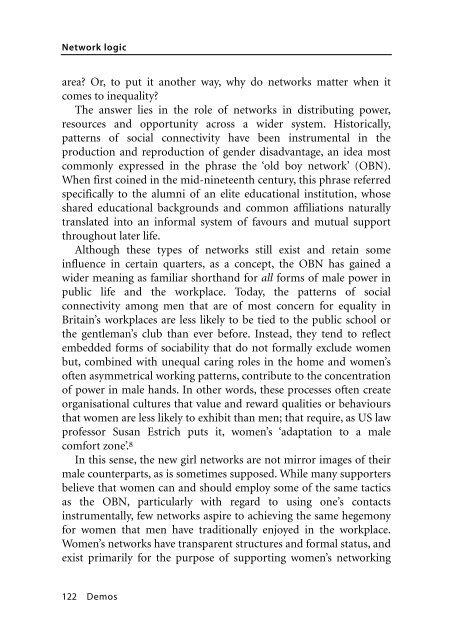Network Logic - Index of
Network Logic - Index of
Network Logic - Index of
You also want an ePaper? Increase the reach of your titles
YUMPU automatically turns print PDFs into web optimized ePapers that Google loves.
<strong>Network</strong> logic<br />
area? Or, to put it another way, why do networks matter when it<br />
comes to inequality?<br />
The answer lies in the role <strong>of</strong> networks in distributing power,<br />
resources and opportunity across a wider system. Historically,<br />
patterns <strong>of</strong> social connectivity have been instrumental in the<br />
production and reproduction <strong>of</strong> gender disadvantage, an idea most<br />
commonly expressed in the phrase the ‘old boy network’ (OBN).<br />
When first coined in the mid-nineteenth century, this phrase referred<br />
specifically to the alumni <strong>of</strong> an elite educational institution, whose<br />
shared educational backgrounds and common affiliations naturally<br />
translated into an informal system <strong>of</strong> favours and mutual support<br />
throughout later life.<br />
Although these types <strong>of</strong> networks still exist and retain some<br />
influence in certain quarters, as a concept, the OBN has gained a<br />
wider meaning as familiar shorthand for all forms <strong>of</strong> male power in<br />
public life and the workplace. Today, the patterns <strong>of</strong> social<br />
connectivity among men that are <strong>of</strong> most concern for equality in<br />
Britain’s workplaces are less likely to be tied to the public school or<br />
the gentleman’s club than ever before. Instead, they tend to reflect<br />
embedded forms <strong>of</strong> sociability that do not formally exclude women<br />
but, combined with unequal caring roles in the home and women’s<br />
<strong>of</strong>ten asymmetrical working patterns, contribute to the concentration<br />
<strong>of</strong> power in male hands. In other words, these processes <strong>of</strong>ten create<br />
organisational cultures that value and reward qualities or behaviours<br />
that women are less likely to exhibit than men; that require, as US law<br />
pr<strong>of</strong>essor Susan Estrich puts it, women’s ‘adaptation to a male<br />
comfort zone’. 8<br />
In this sense, the new girl networks are not mirror images <strong>of</strong> their<br />
male counterparts, as is sometimes supposed. While many supporters<br />
believe that women can and should employ some <strong>of</strong> the same tactics<br />
as the OBN, particularly with regard to using one’s contacts<br />
instrumentally, few networks aspire to achieving the same hegemony<br />
for women that men have traditionally enjoyed in the workplace.<br />
Women’s networks have transparent structures and formal status, and<br />
exist primarily for the purpose <strong>of</strong> supporting women’s networking<br />
122 Demos
















